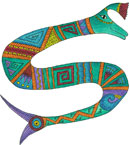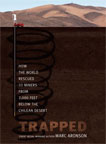 Trapped:
How the World Rescued 33 Miners from 2,000 Feet Below the
Chilean Desert Trapped:
How the World Rescued 33 Miners from 2,000 Feet Below the
Chilean Desert
by Marc Aronson
Ages 8–12
In 2010, 33 miners were trapped
in a Chilean copper mine 2000 feet below the surface
for more than two months. This riveting book tells
the story of those 69 days in 12 short chapters. Photos
and diagrams illustrate both above- and below-ground
scenes, showing the struggles of the trapped men to
stay alive deep inside the mine as their rescuers work
frantically from above. This well-researched and positive
book highlights the amazing technology and the helping
hands from around the world that transformed what could
have been a horrendous tragedy into an amazing story
of survival. |
|
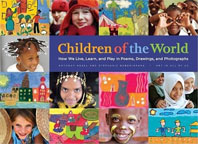 Children
of the World: How We Live, Learn, and Play in Poems, Drawings,
and Photographs Children
of the World: How We Live, Learn, and Play in Poems, Drawings,
and Photographs
by Anthony Asael, Stephanie Rabemiafara
All ages
Children from 192 countries
around the world celebrate their homelands with words
and pictures. Candid photographs, maps, fun facts,
artwork, and poems bring the children from different
countries to life in this celebration of cultural differences
and the similarities of children all over the world. |
|
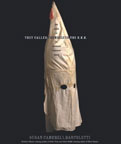 They
Called Themselves the K.K.K.: The Birth of an American Terrorist
Group They
Called Themselves the K.K.K.: The Birth of an American Terrorist
Group
by Susan Campbell Bartoletti
Ages 12–up
This accessible book presents
the origins and development of the Ku Klux Klan through
slave narratives, newspapers, congressional testimony,
and other sources, against the background of the complex
Reconstruction era of 1865–1877. Photographs, engravings,
and illustrations provide a graphic context for KKK
terrorism and the societal forces that provide a growth
medium for hate and terrorist groups. |
|
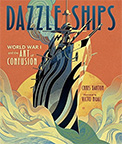 Dazzle Ships: World War I and the Art of Confusion Dazzle Ships: World War I and the Art of Confusion
by Chris Barton, Victo Ngai
Ages 7–11
During World War I, British Lieutenant-commander Norman Wilkinson came up with the idea of painting ships with bold colors and crazy patterns in the hope of confusing the enemy about the ship’s speed and direction. By the end of the war, more than four thousand British and American ships were painted in dazzling designs to protect them from German torpedo attacks. |
|
 The March Against Fear: The Last Great Walk of the Civil Rights Movement and the Emergence of Black Power The March Against Fear: The Last Great Walk of the Civil Rights Movement and the Emergence of Black Power
by Ann Bausum
Ages 12–up
In 1966 James Meredith organized a peaceful march for voter registration in Mississippi. Black rights leaders like leaders like Martin Luther King Jr. and Stokely Carmichael joined the march, an unlikely alliance that resulted in the Black Power movement. Beginning with Meredith’s assassination, this powerful book goes back in time to explain the events that led to the 200-mile walk, known as the March Against Fear, and its aftermath. |
|
 Stonewall: Breaking Out in the Fight for Gay Rights Stonewall: Breaking Out in the Fight for Gay Rights
by Ann Bausum
Ages 12–up
In 1969 being gay in the United States was a criminal offense. Most hid their sexual orientation for fear of losing their jobs or becoming estranged from their families. The Stonewall Inn, a Mafie-run bar in New York City, was one of the few places gays could feel free to be themselves. One hot night in June, the police raided the bar. But the crowd refused to leave quietly and the raid became a riot that triggered a demand for gay civil rights. This exploration of the Stonewall Riots and the national gay rights movement that continues to the present is powerful. |
|
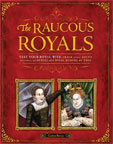 Raucous
Royals: Raucous
Royals:
Test
your Royal Wits: Crack Codes, Solve Mysteries, and Deduce Which
Royal Rumors are True
by Carlyn Beccia
Ages 9–12
This fascinating mix of costumed
caricatures, interactive text, and quizzes encourages the
reader to participate in history rather than just read
about it. The combination picture book/graphic novel is
sure to appeal to middle grade kids. |
|
 Tommy: The Gun That Changed America Tommy: The Gun That Changed America
by Karen Blumenthal
Ages 12–up
John Taliaferro Thompson designed a light quick-firing weapon to help Americans win on the World War I battlefield, but the military wan’t interested in his Thompson submachine gun. Instead, American gangsters, including Chicago’s rival bootlegging gangs, adopted the Tommy gun, which was not covered by concealed-weapons laws and could be purchased at sporting and hardware stores. Mug shots and crime scene photographs capture the lawlessness of the period. An epilogue highlights recent shootings, legislation, and continuing questions about guns in America. |
|
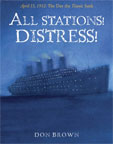 All
Stations! Distress! All
Stations! Distress!
April
15, 1912: The Day the Titanic Sank
by Don Brown
Ages 6–10
This gripping account captures
the grandeur of the Titanic, the terror of the disaster,
and the rescue the survivors. The watercolor and pencil
illustrations capture telling details of of actions and
facial expressions. The causes of the disaster are clearly
explained and gripping first-hand accounts are included. |
|
 Drowned City: Hurricane Katrina and New Orleans Drowned City: Hurricane Katrina and New Orleans
by Don Brown
Ages 12–up
Hurricane Katrina’s monstrous winds and surging water overwhelmed the protective levees around New Orleans, Louisiana, on August 29, 2005. Dynamic as-it-happened narration presents the power of the storm that flooded 80% of the city and claimed 1,833 lives. Stories of selflessness and courage are balanced against examples of racism, incompetence, and criminality. Marking the ten year anniversary of Hurricane Katrina,a portion of the proceeds from this book has been donated to Habitat for Humanity New Orleans. |
|
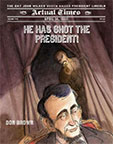 He Has Shot the President!: April 14, 1865: The Day John Wilkes Booth Killed President Lincoln He Has Shot the President!: April 14, 1865: The Day John Wilkes Booth Killed President Lincoln
by Don Brown
Ages 6–9
This fifth in the “Actual Times” series presents the shooting of President Lincoln and then follows Booth’s attempted escape. Lincoln’s death, the investigation to track down Booth and his conspirators, and the eventual hanging of the four members of the assassination plot are presented chronologically with water color illustrations. |
|
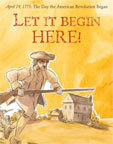 Let
It Begin Here! Let
It Begin Here!
April
19, 1775: The Day the American Revolution Began
by Don Brown
Ages 6–10
This book begins as King George
III wins the Seven Years’ War and realizes his country
needs money. The taxes imposed on the American colonies
eventually lead to the Revolutionary War. Told in a clear
and interesting style, young readers will enjoy reading
about this time in history. |
|
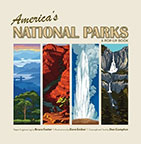 America’s National Parks, a Pop-Up Book America’s National Parks, a Pop-Up Book
by Don Compton, Bruce Foster, Dave Ember
All ages
This cleverly-designed guide features 18 National Parks, six featured as double page pop-ups: Everglades, Great Smoky Mountains, Grand Canyon, Yellowstone, Glacier and Yosemite. Detailed text describes other national parks, lavishly illustrated in the style of vintage WPA posters from the 1930s. |
|
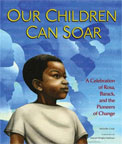 Our
Children Can Soar: Our
Children Can Soar:
A
Celebration of Rosa, Barack, and the Pioneers of Change
by Michelle Cook
Ages 4–8
This beautiful book pays tribute
to 10 African Americans from the Civil Rights movement
to the present. The powerful illustrations by many different
artists complement the text, presenting African-American
history as the story of hope. |
|
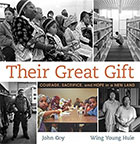 Their Great Gift: Courage, Sacrifice, and Hope in a New Land Their Great Gift: Courage, Sacrifice, and Hope in a New Land
by John Coy
Ages 5–10
Told mainly through photographs, this inspiring look at immigration to the United States focuses on the lives of children. Images of immigrant families from all over the world illustrate the experience of moving to a new country, working hard, making mistakes, and building a new home. |
|
 Eyes Wide Open: Going Behind the Environmental Headlines Eyes Wide Open: Going Behind the Environmental Headlines
by Paul Fleischman
Ages 14–up
This compact yet thorough guide to climate change urges readers to think critically and broadly about the world’s problems. Fleischman gives readers a grounding in critical reading skills needed to recognize the vested interests make by those in power, and to understand media and PR distortions of the truth. Photographs, sidebars, and suggested resources support the hard truths presented. “solving the environment requires looking straight at reality and calculating the costs of our lifestyle and options.” The lively prose style and abundance of illustrations will appeal to young adults while providing the tools they need to become informed, responsible global citizens. |
|
 The Family Romanov: Murder, Rebellion, and the Fall of Imperial Russia The Family Romanov: Murder, Rebellion, and the Fall of Imperial Russia
by Candace Fleming
Ages 12–up
This fascinating history presents an intimate portrait of Tsar Nicholas, his wife Alexandra, and their five children, placing their story firmly in their time of increasing social unrest and turmoil. Letters, diary entries, and memoirs are interwoven with the narration, demonstrating Nicholas’s inability to face the reality of the desperately impoverished Russian peasants, and Alexandra’s dependence on the advice of the the evil monk Rasputin. |
|
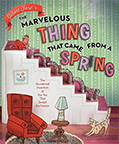 The Marvelous Thing That Came from a Spring: The Accidental Invention of the Toy That Swept the Nation The Marvelous Thing That Came from a Spring: The Accidental Invention of the Toy That Swept the Nation
by Gilbert Ford
Ages 4–8
During WWII, naval engineer Richard James was surprised by the unusual properties of a torsion spring that fell from the shelf above his desk and “walked.” Richard and his wife Betty decide to market the spring as a toy, and debut their Slinky in the toy department of Gimbels. Playful illustrations capture the American optimism of the time and celebrate the inventor mindset. |
|
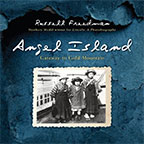 Angel Island: Gateway to Gold Mountain Angel Island: Gateway to Gold Mountain
by Russell Freedman
Ages 9–12
Angel Island, in the San Francisco bay, served as the “Ellis Island” of the west coast, processing around one million people from Japan, China, and Korea, between 1892 and 1940. Because of the strict exclusion laws aimed first at the Chinese, Angel Island was more a detention center than a welcome to the United States. This poignant history is interspersed with the despairing poems written on the barrack walls along with archival photographs and personal vignettes. |
|
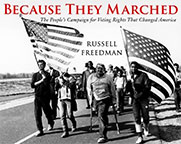 Because They Marched: The People’s Campaign for Voting Rights That Changed America Because They Marched: The People’s Campaign for Voting Rights That Changed America
by Russell Freedman
Ages 10–up
This powerful photo-essay commemorates the 50th anniversary of the march for voting rights from Selma to Montgomery. Frustrated with reprisals for attempting to register to vote, the black community of Selma began to protest. In January 1965, Dr. Martin Luther King, Jr. was attacked by a segregationist while leading a voting rights march. In February, an an Alabama state trooper shot an unarmed demonstrator, inspiring a march from Selma to the state capital. On March 7th, law officers attacked the peaceful demonstrators. Broadcast around the world, this attack spurred the protesters to complete the march at any cost, finally completing the 54 mile walk on March 25th, arriving in Montgomery, Alabama, to the cheers of a crowd of 25,000 supporters. |
|
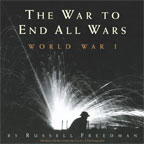 The
War to End All Wars: World War I The
War to End All Wars: World War I
by Russell Freedman
Ages 12–up
This powerful book begins with
the assassination of Archduke Franz Ferdinand in 1914
and ends with the Treaty of Versailles in 1918. The
accessible narrative shows the brutality and horror
of trench warfare along with the leaders and the new
technology that made it all possible. The ramifications
of the war—the end to American isolation, the Russian
revolution, and the defeat that provided a foundation
for Fascism and Nazism—are clearly demonstrated. |
|
 Writing Radar: Using Your Journal to Snoop Out and Craft Great Stories Writing Radar: Using Your Journal to Snoop Out and Craft Great Stories
by Jack Gantos
Ages 9–12
Newbery Award Medalist Jack Gantos uses stories he wrote as a youth in his journal as proof that keeping a journal is the best tool for aspiring authors. Short chapters give practical advice about developing technique and activating one’s Writing Radar — the heightened awareness an author must have. “You need a certain writerly attitude as you walk down the street — a kind of stealthy, snoopy, slinky, shifty, sinister, and silent confidence.” This encouraging and humorous guide is the perfect gift for all aspiring writers. |
|
 Timeline: A Visual History of Our World Timeline: A Visual History of Our World
by Peter Goes
Ages 10–up
This large-format book examines the history of the world from the Big Bang through modern day. Each spread covers a different time period with illustrations, captions, and short blocks of text highlighting mass extinctions, wars, natural disasters, and cultural trends. The visual timeline is powerful and has plenty of details to spark interest. |
|
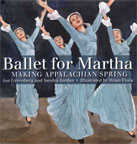 Ballet
for Martha: Making Appalachian Spring Ballet
for Martha: Making Appalachian Spring
by Jan Greenberg and Sandra Jordan,
Brian Floca
Ages 6–10
This inspired book captures
the excitement of dance, music, and stage design
while celebrating the collaboration between dancer
Martha Graham, composer Aaron Cop,and, and set designer
Isamu Noguchi. The book follows the creation of a
ballet from Martha’s original idea to the opening
night, highlighting the vital contributions from
each of the artists. |
|
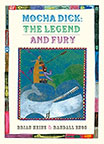 Mocha Dick: The Legend and the Fury Mocha Dick: The Legend and the Fury
by Brian Heinz, Randall Enos
Ages 6–up
Mocha Dick, a white whale named for the island near Chile where he was first sighted in 1810, was hunted, wounded, and barely survived. Harpoons blinded him in one eye, and caused him to attack whale boats in revenge, sinking harpoon boats and killing the whalers. When Mocha Dick was finally killed, heads of 19 harpoons were found in his body. An 1839 magazine article about Mocha Dick inspired Herman Melville to write Moby Dick 12 years later. |
|
 Titanic:
Voices From the Disaster Titanic:
Voices From the Disaster
by Deborah Hopkinson
Ages 8–12
This intimate view of the Titanic
disaster is told through the stories of a handful of
survivors including an American teenager, a science
teacher from England, a stewardess born in Argentina,
and a nine-year-old British boy. The sinking of the
ship, the rush for the lifeboats, and the terrifying
wait for the arrival of the rescue ship Carpathia are
presented with fast-paced drama. |
|
 The Boys Who Challenged Hitler: Knud Pedersen and the Churchill Club The Boys Who Challenged Hitler: Knud Pedersen and the Churchill Club
by Phillip Hoose
Ages 12–up
In April 1940, Germany made Denmark a “protectorate” of the Third Reich. The Danish government did not oppose the German invasion, but a small group of Danish teens were ashamed of their nation’s cowardice and decided to fight back. Led by 15-year-old Knud Pedersen, the teens formed the Churchill Club, named after British Prime Minister Winston Churchill. For five months in 1940, members of the club performed daring acts of sabotage, mostly from their bikes and often in broad daylight. The boys were arrested and imprisoned, but their courage fueled Danish resistance. Verbatim quotes from a 2012 interview with Knud Petersen are interwoven with the narration. An epilogue tells what happened to each member of the Churchill Club after the end of the war. |
|
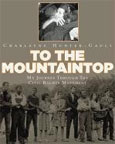 To
the Mountaintop: My Journey Through the Civil Rights Movement To
the Mountaintop: My Journey Through the Civil Rights Movement
by Charlayne Hunter-Gault
Ages 12–up
This accessible historical
memoir tells the story of the author’s harassment and
threats when she entered the University of Georgia
in 1959. Other chapters tell of other struggles for
equal rights: lunch counter sit-ins, Freedom Riders,
voter registration drives. The personal look at political
struggle is both educational and inspiring. |
|
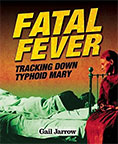 Fatal Fever: Tracking Down Typhoid Mary Fatal Fever: Tracking Down Typhoid Mary
by Gail Jarrow
Ages 10–up
Mary Mallon worked as a cook in 1907 New York City. Mary was infected with typhoid, but had no symptoms of the disease, and inadvertently infected numerous people with the deadly disease. George Albert Soper, a sanitation engineer and typhoid expert, and Sara Josephine Baker, a doctor working at the New York City Department of Health, followed the trail of infection back to Mary, who was virtually imprisoned on North Brother Island in New York’s East River order to prevent the further spread of the disease. This true story is written in the style of a gripping thriller. |
|
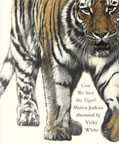 Can
We Save the Tiger? Can
We Save the Tiger?
by Martin Jenkins, Vicky White
Ages 5–8
Incredible artwork and a good
balance between good and bad news about the tiger and
other endangered species make this book an enjoyable
and excellent resource. Other species featured are
the partula snail, white-rumped vulture, and American
bison. |
|
 Animals Upside Down: A Pull, Pop, Lift & Learn Book! Animals Upside Down: A Pull, Pop, Lift & Learn Book!
by Steve Jenkins, Robin Page
Ages 4–8
This clever interactive book uses tabs, wheels, and pop-ups to examine reasons that animals turn themselves upside down. A jellyfish rests on its back to feed, the flamingo turns its head upside down to use its beak as a filter while feeding, a sparrow hawk flips upside down in midair to catch its prey. Striking artwork makes the unusual animal behavior come alive. |
|
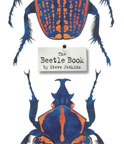 The
Beetle Book The
Beetle Book
by Steve Jenkins
Ages 4–8
This large-format book introduces
the world of beetles, which make up one-fourth of every
kind of plant and animal on Earth. Striking illustrations
and intriguing information present basic beetle anatomy
and facts about specific species. |
|
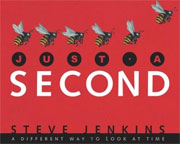 Just
a Second Just
a Second
by Steve Jenkins
Ages 4–8
This thought-provoking book examines
diverse events that occur in the space of a second, a
minute, an hour, etc. In one second, a black mamba snake
can slither 24 feet while a cheetah can sprint 100 feet.
In one week a ladybug will eat more than 500 aphids.
Fascinating observations like these will inspire readers
to think about time and the world in new ways. |
|
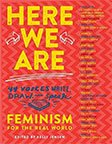 Here We Are: Feminism for the Real World Here We Are: Feminism for the Real World
by Kelly Jensen
Ages 14–up
This powerful yet accessible scrapbook style book presents reflections by 44 writers, dancers, actors, and artists on the topic of feminism. The contributions include essays, illustrations, playlists, comics, and poems from diverse perspectives, covering topics including gender identity, body image, creativity, mental illness, etc. |
|
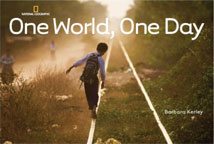 One
World, One Day One
World, One Day
by Barbara Kerley
Ages 4–up
Sixty beautiful photographs
follow children all around the world as they eat breakfast,
go to school, and live a normal day. The global perspectives
of the numerous photographers echo the theme of one
global family. |
|
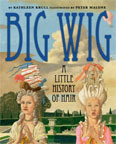 Big
Wig Big
Wig
by Kathleen Krull, Peter Malone
Ages 8–12
This playful “history
of hair” follows our fascination with hair from
prehistory to the punks. The humorous gouache illustrations
beautifully complement the information about hair fashions
and follies in ancient Egypt, Mexican, and Indian societies
and through the royal courts of Europe to modern times. |
| |
|
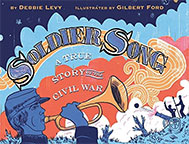 Soldier Song: A True Story of the Civil War Soldier Song: A True Story of the Civil War
by Debbie Levy, Gilbert Ford
Ages 8–10
Two years into the Civil War the Union army has just been defeated in the battle of Fredericksburg, Virginia, and retreats across the river. Entrenched for the winter, songs floating across the water create a temporary connection. Interspersed excerpts from the letters soldiers wrote home add a personal poinancy, hightlighted by a final exchange of “Home, Sweet Home” sung by homesick soldiers on both sides of the river. |
|
 The
Year of Goodbyes: A True Story of Friendship, Family and
Farewells The
Year of Goodbyes: A True Story of Friendship, Family and
Farewells
by Debbie Levy
Ages 10–up
This book tells the true story
of a year in the life of Jutta, a 12-year-old girl in
1938 Nazi Germany, and the author’s mother. Photos and
translations of comments from friends written in Jutta’s
diary introduce each chapter, giving a vivid picture
of an ordinary teenager in an extraordinary time and
place. This very personal and powerful book in verse
documents a year of change, confusion, cruelty, and farewells. |
|
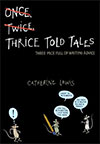 Thrice Told Tales: Three Mice Full of Writing Advice Thrice Told Tales: Three Mice Full of Writing Advice
by Catherine Lewis, Joost Swarte
Ages 12–up
This clever book uses the three blind mice to illustrate nearly 100 elements of writing and literature: plot, dialog, flashbacks, coincidence, etc. Literary styles are presented with samples like Dickens Mouse and Hemingway Mouse. Witty cartoons add to the fun in this funny and useful reference for writers and their teachers. |
|
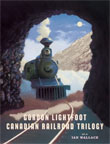 Canadian
Railroad Trilogy Canadian
Railroad Trilogy
by Gordon Lightfoot, Ian Wallace
Ages 4–up
The lyrics of Lightfoot’s 1967
song describe the construction of the transcontinental
Canadian Pacific Railway, commissioned to mark Canada’s
Centennial. Wallace’s beautiful paintings celebrate
the Canada’s natural beauty while also illustrating
the damage to First Nation people and the hardships
of those who toiled to build the railroad. Many paintings
show the railway in detail, while others focus on the
history and settlement of Canada. |
|
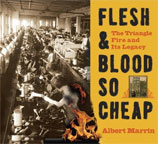 Flesh
and Blood So Cheap: The Triangle Fire and its Legacy Flesh
and Blood So Cheap: The Triangle Fire and its Legacy
by Albert Marrin
Ages 10–up
On March 25, 1911, the Triangle
Shirtwaist Factory in New York City burst into flames.
The factory was crowded with workers, mainly young
Italian and Jewish women. The doors were locked to
prevent the workers from leaving before the end of
the work day, and 146 people died in the fire. One
hundred years later, this powerful book examines the
poor working conditions the immigrant factory workers
endured, the greed that motivated the bosses and owners,
and the courage of the workers who banded together
to change working conditions for everyone in America. |
|
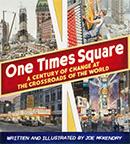 One Times Square: A Century of Change at the Crossroads of the World One Times Square: A Century of Change at the Crossroads of the World
by Joe McKendry
Ages 6–10
One Times Square, the former headquarters of the New York Times and the skyscraper that gave the square its name in 1904, still stands at the intersection of Broadway and Seventh Avenue in New York City. This fascinating book chronicles the change from livery stables and coal yards to a theater district and advertising mecca with beautifully detailed illustrations of buildings, street scenes, and billboards. |
|
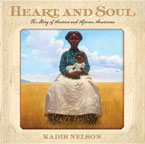 Heart
and Soul: The Story of America and African Americans Heart
and Soul: The Story of America and African Americans
by Kadir Nelson
Ages 9–up
From pre-Revolutionary slavery
to the election of President Obama, this powerful book
documents the story of a people whose struggles and
achievements helped to define America. The grandmotherly
narrator tells the story of injustice, courage, hope,
and inspiration from her ancestors arrival on a slave
ship to her recent vote for an African American president.
Dramatic oil paintings present the determination and
strength of both well known historical figures and
everyday people. The intimate and personal narration
make this inspiring book accessible to young readers. |
|
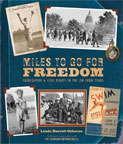 Miles
to Go for Freedom: Segregation and Civil Rights in the Jim
Crow Years Miles
to Go for Freedom: Segregation and Civil Rights in the Jim
Crow Years
by Linda Barrett Osborne
Ages 10–14
Continuing the story begun
in Traveling
the Freedom Road, this thought-provoking book examines
racial segregation and early civil rights efforts in
the United States from the 1890s to 1954—the
Jim Crow years. First-person accounts, photographs,
and other primary sources capture the period’s violence,
dehumanization, and individual and collective defiance. |
|
 Hidden Like Anne Frank: 14 True Stories of Survival Hidden Like Anne Frank: 14 True Stories of Survival
by Marcel Prins, Peter Henk Steenhuis
Ages 12–up
Hundreds of children went into hiding, like Anne Frank, to escape the Nazis. This powerful book presents 14 accounts from Dutch-born children, including the story of Prins’s own mother, who went into hiding and survived the war. though these 14 survived, the trauma wasn’t over when the war ended, since most lost family members and their homes forever. This powerful book makes the 14 different experiences real and dramatic. |
|
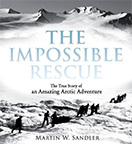 The Impossible Rescue: The True Story of an Amazing Arctic Adventure The Impossible Rescue: The True Story of an Amazing Arctic Adventure
by Martin W. Sandler
Ages 10–14
In 1897 the early arrival of winter trapped eight San Francisco-based whaling ships off the western coast of Alaska. President McKinley ordered an expedition to rescue the 265 stranded whalers. Brought to vivid life through the use of primary sources — journals, reports, letters, and photographs — this suspenseful rescue attempts is told from both the perspective of the rescuers facing danger to save the whalers, and the whalers themselves struggling to survive in life-threatening conditions. |
|
 To
Timbuktu: Nine Countries, Two People, One True Story To
Timbuktu: Nine Countries, Two People, One True Story
by Casey Scieszka, Steven Weinberg
Ages 14–up
This entertaining travelogue
follows the author and illustrator on their two-year
goddess around the world. After graduating from college,
the couple taught English in Beijing, traveled through
Shanghai, Vietnam, Laos, and Thailand, and studied
the role of Islam in the educational system of Mali.
The present tense narration and cartoon sketches add
sparkle to the exploration of each country’s language,
food, traditions, and politics, while highlighting
the friendships made throughout the trip. |
|
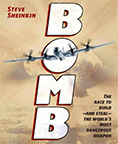 Bomb: The Race to Build—and Steal—the World’s Most Dangerous Weapon Bomb: The Race to Build—and Steal—the World’s Most Dangerous Weapon
by Steve Sheinkin
Ages 10–up
This high-interest book tells the exciting tale of the race to build the first atomic weapon. In 1938, a German chemist split the first Uranium atom. Soviet spies worked their way into American and British scientific communities. A Norwegian commando force attacked a German heavy-water plant. And in the American desert a group of brilliant scientists worked in secret labs in Los Alamos. The suspenseful narration transforms this history into a thriller. |
|
 Lincoln’s Grave Robbers Lincoln’s Grave Robbers
by Steve Sheinkin
Ages 10–12
In 1875, master counterfeiter Ben Boyd is arrested by the Secret Service and thrown into prison. James Kennally, leader of one of the largest counterfeiting rings in the Midwest comes up with a plan to spring his best engraver from jail — steal Lincoln’s body from the tomb in Springfield and ransom it back for Boyd’s release and $200,000 in cash. This suspenseful tale of real-life historical intrigue is as exciting as a fictional thriller. |
|
 Most Dangerous: Daniel Ellsberg and the Secret History of the Vietnam War Most Dangerous: Daniel Ellsberg and the Secret History of the Vietnam War
by Steve Sheinkin
Ages 10–14
In 1971, Daniel Ellsberg, an obscure government analyst, leaked The Pentagon Papers, a 7,000 page collection of papers documenting the secret history of the Vietnam War. The Pentagon Papers exposed a pattern of deception that spanned 20 years and four presidencies, forever changing the relationship between the American people and the politicians who claimed to represent their interests. This accessible history presents the story with the excitement of a spy novel, portraying Daniel Ellsberg as a man who risked everything to expose years of government lies. |
|
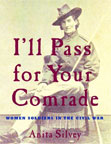 I’ll
Pass For Your Comrade: I’ll
Pass For Your Comrade:
Women
Soldiers in the Civil War
by Anita Silvey
Ages 10–14
This non-fiction book tells the
fascinating story of the women who risked their lives and
reputations to fight in the Civil War. Vintage photographs,
etchings, and memoirs illuminate the adventures and struggles
of the women who cut their hair and disguised themselves
as men to join the fight. Highly accessible language helps
to put these unconventional women in historic context. |
|
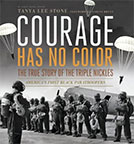 Courage Has No Color, The True Story of the Triple Nickles: America’s First Black Paratroopers Courage Has No Color, The True Story of the Triple Nickles: America’s First Black Paratroopers
by Tanya Lee Stone
Ages 10–up
During World War II enlisted black men are segregated from while soldiers and given less important assignments. At Fort Benning, Georgia, the black soldiers in First Sergeant Walter Morris’s unit act as guards while the white soldiers are trained as paratroopers. The story of the 555th Parachute Infantry Battalion tells the story of America’s first black paratroopers who had to battle against racism to earn the right to fight for their country. |
|
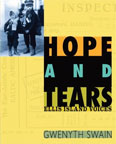 Hope
and Tears: Ellis Island Voices Hope
and Tears: Ellis Island Voices
by Gwenyth Swain
Ages 8–up
Photographs paired with poems give
an intimate look at some of the 12 million immigrants that
passed through Ellis Island between 1892 and 1954. |
|
 “The President Has Been Shot!”: The Assassination of John F. Kennedy “The President Has Been Shot!”: The Assassination of John F. Kennedy
by James L. Swanson
Ages 12–up
An overview of John F. Kennedy’s life and a profile of Lee Harvey Oswald bracket the dramatic account of Kennedy’s assassination on November 22, 1963. Diagrams, period photographs, and source notes supplement the text. |
|
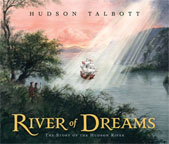 River
of Dreams: River
of Dreams:
The
Story of the Hudson River
by Hudson Talbott
Ages 6–8
The series of watercolor spreads
traces the role of the Hudson River through the colonization
of New York, the era of steamboats, the building of the
Erie Canal, and environmental degradation. Packed with
facts, maps, and timelines, this amazing book manages
to present an astounding among of information without
overwhelming young readers. |
|
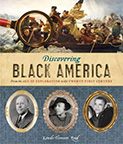 Discovering Black America: From the Age of Exploration to the Twenty-First Century Discovering Black America: From the Age of Exploration to the Twenty-First Century
by Linda Tarrant-Reid
Ages 10–up
This comprehensive history of black Americans begins with early black explorers and the roots of slavery and concludes with the inauguration of Barack Obama as president. Chapters examine the Revolutionary War, the Civil War, Reconstruction, the Jim Crow era, and 20th century social, political, and artistic movements. This accessible book will inspire readers to think more broadly and deeply about the African-American experience. |
|
 Does This Happen to Everyone?: A Budding Adult’s Guide to Puberty Does This Happen to Everyone?: A Budding Adult’s Guide to Puberty
by Jan Von Holleben, Antje Helms
Ages 12–up
This empathetic and respectful guide answers questions about puberty in a direct and sensitive way that will appeal to both parents and children. Common questions receive both funny as well as serious and comprehensive answers. An excellent alternative to information mined from the Internet, this comprehensive guide is entertaining as it calms common worries and fears. |
|
 Speak a Word for Freedom: Women against Slavery Speak a Word for Freedom: Women against Slavery
by Janet Willen, Marjorie Gann
Ages 12–up
This tribute to the women who fought and continue to fight against human rights abuses is inspiring, and perhaps unsettling to those who think of slavery as only a historical fact. Familiar women like Harriet Tubman and Harriet Beecher Stowe share the limelight with lesser known women. Ellen Craft, the daughter of a slave and the plantation owner, disguised herself as a white slave owner to escape north with her black husband. Alice Seeley Harris documented the atrocities against Congolese rummer workers with her powerful photographs. Micheline Slattery, who was enslaved in both Haiti and the United States speaks on behalf of other victims. |
|
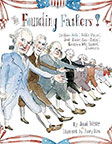 The Founding Fathers!: Those Horse-Ridin’, Fiddle-Playin’, Book-Readin’, Gun-Totin’ Gentlemen Who Started America The Founding Fathers!: Those Horse-Ridin’, Fiddle-Playin’, Book-Readin’, Gun-Totin’ Gentlemen Who Started America
by Jonah Winter, Barry Blitt
Ages 5–8
This energetic book presents the 14 men who lead the charge to found the United States as vibrant individuals with unique strengths and weaknesses. Each spread presents one of the men with a watercolor caricature featuring his most famous attribute along with a brief biography and a list of facts and statistics (height, hobbies, education, wealth, etc.). |
|
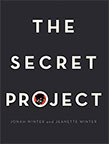 The Secret Project The Secret Project
by Jonah Winter, Jeanette Winter
Ages 5–8
At a former boarding school in the remote desert of New Mexico, a group of scientists have gathered to work on a secret project. They call their invention "The Gadget," since it is too dangerous and classified to call by it’s real name — the Atomic Bomb. This simple introduction to the Manhattan project at Los Alamos is perfect for young readers. |
| |
|
